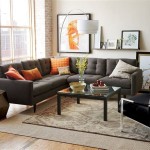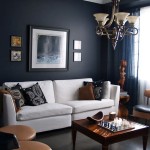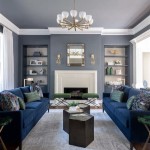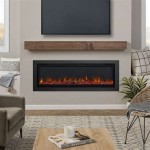Pictures of Blue Living Rooms: Inspiration and Design Ideas
Blue, a color often associated with tranquility, stability, and depth, is a popular choice for living rooms. Its versatility allows it to be incorporated in various design styles, from coastal and contemporary to traditional and bohemian. Exploring pictures of blue living rooms can provide a wealth of inspiration for homeowners and designers alike, offering insights into color palettes, furniture selection, and decorative accents that create harmonious and inviting spaces. This article delves into the multifaceted possibilities of blue living rooms, presenting various design approaches and highlighting key elements that contribute to a successful and aesthetically pleasing result.
Understanding the Psychology of Blue in Interior Design
Blue, in its diverse shades, evokes a range of emotions and psychological responses. Light blues, such as powder blue and sky blue, are associated with calmness, serenity, and openness, making them ideal for creating a relaxed and airy atmosphere. These lighter hues can visually expand a room, making it feel more spacious and inviting. Darker blues, like navy blue and indigo, convey a sense of sophistication, stability, and depth. They can add a touch of drama and elegance to a living room, particularly when contrasted with lighter colors and metallic accents. The selection of a specific blue shade should be carefully considered in relation to the desired mood and overall aesthetic of the space.
The psychological impact of blue also extends to its ability to promote focus and concentration. This makes it a suitable choice for living rooms that serve as multi-functional spaces, incorporating areas for reading, working, or engaging in other activities that require mental acuity. Blue's association with tranquility can help to minimize distractions and create a conducive environment for productivity and relaxation.
Furthermore, blue is often perceived as a gender-neutral color, making it a versatile option for shared living spaces. Its adaptability allows it to be easily incorporated into design schemes that cater to diverse tastes and preferences, creating a comfortable and welcoming environment for all occupants.
Exploring Different Shades and Color Palettes
The success of a blue living room design hinges on the careful selection of shades and the creation of a harmonious color palette. The options are vast, ranging from soft pastels to deep, saturated hues. Understanding how different shades interact with each other and with other colors is crucial for achieving the desired effect.
A classic approach involves pairing blue with neutral colors such as white, beige, and gray. This combination creates a balanced and timeless aesthetic, allowing the blue to take center stage while the neutrals provide a calming backdrop. Introducing textures through fabrics and materials can add depth and visual interest to this palette, preventing it from feeling monotonous.
For a more vibrant and dynamic look, consider pairing blue with complementary colors like orange or yellow. These contrasting hues create a striking visual impact, adding energy and personality to the living room. However, it's important to use these complementary colors sparingly to avoid overwhelming the space. Accents such as throw pillows, artwork, and decorative objects can be used to introduce these pops of color.
Another popular option is to create a monochromatic blue scheme, using different shades and tints of blue to create a layered and sophisticated look. This approach requires careful consideration of the undertones of each shade to ensure that they harmonize effectively. Incorporating different textures and patterns can also add visual interest to a monochromatic scheme.
Beyond the primary color palette, consider the impact of natural light on the blue hues. Blue can appear cooler and more subdued in rooms with limited natural light, while it can appear brighter and more vibrant in rooms with ample sunlight. It is essential to test paint samples under different lighting conditions to ensure that the chosen shades achieve the desired effect.
Incorporating Blue Through Furniture, Accents, and Textiles
Blue can be incorporated into a living room in various ways, from painting the walls to selecting furniture, textiles, and decorative accents. The extent to which blue is used depends on the desired impact and the overall design style.
Painting the walls blue is a bold and impactful choice that can transform the entire atmosphere of a room. For smaller spaces, lighter shades of blue are generally recommended to create a sense of openness and airiness. In larger rooms, darker shades of blue can be used to create a more intimate and dramatic feel. Wallpaper with blue patterns is another effective way to introduce blue into the space, adding texture and visual interest.
Furniture is another key element in incorporating blue into a living room. A blue sofa or armchair can serve as a focal point, adding a touch of color and personality to the space. Blue furniture can be paired with neutral walls and accessories to create a balanced and sophisticated look. Upholstery fabrics in different shades and textures of blue can also be used to add depth and visual interest.
Textiles, such as rugs, curtains, and throw pillows, offer a flexible and affordable way to introduce blue into a living room. These elements can be easily swapped out to change the look and feel of the space, allowing for seasonal updates or stylistic adjustments. Blue patterned rugs can add a touch of visual interest and define different zones within the living room. Curtains in shades of blue can filter light and create a calming atmosphere. Throw pillows in varying shades and textures of blue can add comfort and visual appeal to sofas and armchairs.
Decorative accents, such as artwork, vases, and lamps, provide opportunities to add subtle pops of blue to a living room. Blue artwork can complement the overall color scheme and add a personal touch to the space. Blue vases and other decorative objects can be strategically placed to draw the eye and add visual interest. Lamps with blue shades can provide soft and ambient lighting, enhancing the overall atmosphere of the room.
Consider the interplay of textures when incorporating blue into a living room. Pairing smooth surfaces, such as painted walls, with textured elements, such as woven rugs and linen curtains, can add depth and visual interest to the space. Mixing different textures can also create a more tactile and inviting environment.
Design Styles That Complement Blue Living Rooms
Blue's versatility allows it to be seamlessly integrated into various design styles, each with its unique characteristics and aesthetic principles. Understanding how blue interacts with different design styles can help homeowners and designers create a cohesive and visually appealing living room.
Coastal design is a natural fit for blue, evoking the serenity and tranquility of the ocean. Light blues, such as sky blue and turquoise, are commonly used in coastal living rooms, often paired with white, beige, and natural textures such as wood and rattan. Nautical-themed accents, such as seashell decorations and rope details, can further enhance the coastal aesthetic.
Contemporary design also embraces blue, often using it as a grounding color in minimalist and streamlined spaces. Darker blues, such as navy blue and charcoal blue, are frequently paired with geometric patterns, metallic accents, and sleek furniture. The emphasis is on clean lines, functionality, and a sophisticated aesthetic.
Traditional design often incorporates blue in a more formal and elegant manner. Classic shades of blue, such as Wedgwood blue and French blue, are commonly used in traditional living rooms, often paired with antique furniture, ornate details, and rich fabrics such as velvet and silk. The focus is on creating a timeless and refined atmosphere.
Bohemian design embraces a more eclectic and free-spirited approach to incorporating blue. A variety of blue shades, from vibrant turquoise to muted indigo, can be used in bohemian living rooms, often paired with colorful textiles, vintage furniture, and natural elements such as plants and macrame. The emphasis is on creating a comfortable and personalized space that reflects the homeowner's unique style.
Mid-century modern design can also effectively utilize blue. The clean lines and simple shapes of mid-century modern furniture pair well with bold and saturated blues, such as teal and royal blue. Accents in contrasting colors, such as mustard yellow and burnt orange, can add a touch of retro flair to the space.
When selecting a design style for a blue living room, consider the existing architectural features of the space, as well as the homeowner's personal preferences. It is important to create a cohesive and harmonious design that reflects the individual's taste and lifestyle.
Lighting Considerations for Blue Living Rooms
Lighting plays a critical role in shaping the atmosphere of any living room, and its importance is amplified when working with blue hues. The way light interacts with different shades of blue can significantly impact the overall mood and aesthetic of the space.
Natural light is always a valuable asset, and maximizing its presence in a blue living room is essential. Large windows and skylights can flood the space with natural light, enhancing the vibrancy and depth of the blue tones. Light-filtering curtains or blinds can be used to control the amount of natural light entering the room, preventing glare and creating a softer, more diffused effect.
Artificial lighting should be carefully planned to complement the natural light and create a warm and inviting atmosphere. Layered lighting, which combines ambient, task, and accent lighting, is an effective approach. Ambient lighting, such as recessed lighting or a ceiling fixture, provides general illumination for the room. Task lighting, such as table lamps or floor lamps, provides focused light for reading or other activities. Accent lighting, such as spotlights or picture lights, highlights specific features of the room, such as artwork or architectural details.
The color temperature of the light bulbs also plays a crucial role. Warm white light bulbs (2700-3000K) create a cozy and inviting atmosphere, while cool white light bulbs (3500-4100K) provide a brighter and more energizing feel. The choice of color temperature should be based on the desired mood and the overall aesthetic of the living room.
Consider using dimmers to control the intensity of the artificial lighting, allowing for flexibility in creating different moods throughout the day. Dimmer switches can be used on ambient, task, and accent lighting fixtures.
In rooms with limited natural light, it is important to use artificial lighting strategically to compensate. Brighter light bulbs can be used to create a sense of openness and airiness. Mirrors can also be used to reflect light and visually expand the space.

Blue Living Rooms Design Ideas Schemes Farrow Ball

40 Blue Living Room Ideas Transform Your Space With Calming Hues

Blue Living Rooms Design Ideas Schemes Farrow Ball

Fabulous Blue Living Room Ideas Decorating With Calm Accents Shabbyfufu Com

Beautiful Blue Living Rooms Oblique New York

Blue Living Rooms Design Ideas Schemes Farrow Ball
:max_bytes(150000):strip_icc()/24.WestportModernFarmhousebyChangoCo.-FormalLivingRoom-99086dc25b1648798a298e338ad50cdc.jpg?strip=all)
47 Blue Living Room Ideas For Every Style

Blue Living Room Ideas How To Decorate With This Timeless Shade House Garden

25 Best Blue Rooms Decorating Ideas For Walls And Home Decor

Beautiful Blues Inspiration For Decorating A Blue Living Room Newbury Home








